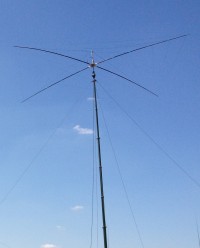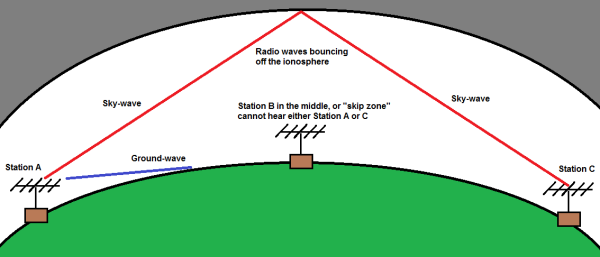 This article is split into 3 parts:”The HF Bands“, “Choosing a Radio“, and “Aerials.” The content here is primarily aimed at the Foundation/Intermediate licence-holder, therefore a number of topics (especially those surrounding propagation) have been kept “simple” on purpose. Whether you’ve just got your licence and want to get onto HF quickly, or have been active on 2m for a while and want to “take the plunge” into HF, then this article should help you get to know what to expect from the bands and how to get the most out of your station.
This article is split into 3 parts:”The HF Bands“, “Choosing a Radio“, and “Aerials.” The content here is primarily aimed at the Foundation/Intermediate licence-holder, therefore a number of topics (especially those surrounding propagation) have been kept “simple” on purpose. Whether you’ve just got your licence and want to get onto HF quickly, or have been active on 2m for a while and want to “take the plunge” into HF, then this article should help you get to know what to expect from the bands and how to get the most out of your station.
In Part 3 we will cover aerials – Especially those that can work in a small (<50ft) garden or perhaps where stealth operation is your primary concern. Your antenna system is the most important aspect of your station and we’ll explain how to make it as efficient as possible. Introduction to HF – Part 2 covers radios and include a few suggestions for both new and second-hand transceivers – Some of the more advanced/useful features will also be covered such as IF-Shift, VFO-Split and DSP Filtering.
The HF Bands
This first part introduces the HF bands and explains how they work and what you can expect to hear at a given time. There is something for everyone on HF, whether you want to speak to a friend “up north” or chase new Countries (ie: DX’ing). A range of modes are used – Not just voice and Morse code but PSK, RTTY, JT and even SSTV (slow-scan television). The WARC bands (30m, 17m, 12m) are so-called due to their inclusion in the Amateur Radio bandplan during the World Administrative Radio Conference in 1979 and are free of contest activity – Thereby offering a safe sanctuary from those who prefer a longer QSO or wish to find a more challenging DX contact!
First, a quick look at what is known as “skip” – Radio waves at VHF typically travel line-of-sight which is why an aerial should be as high up as possible. On HF, waves travel as a ground-wave before dramatically attenuating, however the waves also travel upwards (known as sky-wave) and then (hopefully) bounce off of the ionosphere and come back down many hundreds of miles away. The image below explains how it is possible for Station A and Station C who are 1000 miles away to communicate, but also explains why Station B in the middle (with only 500 miles between each station) may not hear either.
The time of day also affects how (and if) the signals bounce off the ionosphere – A brief look at propagation is to be carried-out in Part 3 : Aerials.

Here’s a description of the various HF bands, their characteristics and some frequencies to try listening to:
1.8MHz (160m) and 3.5MHz (80m)
The lowest of the HF bands, these are restricted to short range (under 300 miles) during the day due to D-Layer absorption but after sunset the atmosphere reflects the waves allowing signals from Europe and afar. As you can see from the wavelength, dipoles for these bands are 80m and 40m in length respectively – Fine if you have a big garden, but you will struggle if you have a typical 50ft garden. In Part 3 we will discuss aerials and getting the most from a small garden.
7MHz (40m)
This is the band where you’ll find lots of UK stations during the day. During daylight hours, 40m is good for around 500-miles and is therefore good for “inter-G” QSOs and, with Essex being close to the Continent, easy QSOs over to France, Germany and the Netherlands. As the sun sets, the band starts to go long-skip and you’ll hear less UK-stations and more Continentals – Overnight you can expect to hear signals from North and South America.
CW: 7.000 – 7.040
PSK: 7.042
SSB: 7.050 – 7.200
10MHz (30m) – WARC band, contest-free
A small band, 10.100 – 10.150MHz with no voice operation. This band is for CW (Morse) and datamodes such as PSK, RTTY and JT65. Sitting in-between 7MHz and 14MHz, it enjoys properties of both bands with fairly local (inter-EU) propagation during the daytime. After-dark you may hear stations from America.
14MHz (20m)
Usually known as the “DX Band” due to its reliability for something to be worked at any time of the day. It’s very popular during the day with signals from across the World but if you want to work Australia, you’ll need to be an early riser as propagation to VK is best around sunrise. Due to the way the radio waves travel (and bounce/skip), on this band you are unlikely to hear much activity from within 500 miles unless the station is very local to you. There is lots of daytime activity around 14.070 using the PSK mode.
CW: 14.000 – 14.070
PSK: 14.070
JT65: 14.076
RTTY: 14.080 – 14.099
SSB: 14.100 – 14.350
18MHz (17m) – WARC band, contest-free
Similar in many ways to 14MHz, this band is also affected by solar activity. During the day, this band typically offers great propagation over to America with South America getting stronger late afternoon until sunset.
21MHz (15m)
Another interesting DX band – If you’re interested in working Asia, listen just after sunrise and until about Midday. You can then expect signals from the USA for the remainder of the day. This is a fairly large band so there’s plenty of room for CW, digimodes and SSB.
CW: 21.000 – 21.070
PSK: 21.070
SSB: 21.150 – 21.450
24.9MHz (12m) – WARC band, contest-free
Offering some of the properties of 21MHz and some of 28MHz, this is a bad that can experience Sporadic E openings during the summer.
28MHz (10m)
A band that is affected by sunspots and thus exhibits very changeable properties ranging from nothing to chaos. Sporadic E is common May through August and during the peak of the sunspot-cycle, regular long-distance communications are possible. Often enjoyed by mobile stations operating 10m FM making QSOs between the UK and USA as easy as a local 2m FM QSO.
CW: 28.000 – 28.070
JT65: 28.076
PSK: 28.120
SSB: 28.225 – 28.600
CQ DX, CQ DX…
The concept of “DX” on HF usually means “a different Continent” so when you hear a European calling CQ DX then he probably isn’t interested in speaking to you (no matter how much you want to speak to him!). Of course, there are plenty of stations who will be happy to work you, especially if they’re simply calling CQ or they happen to reply to your call.
Unlike VHF, there are no dedicated calling frequencies on the HF bands, simply pick a clear frequency in the mode-area you are using – Ask if the frequency is clear a few times (or send QRL? if you’re using CW or PSK/RTTY), then start to call CQ.
Getting onto HF doesn’t have to involve an expensive transceiver and big/long aerials in your garden – A reasonable second-hand radio and a tuned dipole for your band of interest would suffice. Of course, each band has its own merits so if you want to be efficient on multiple bands, you’ll have to get creative when it comes to an antenna solution. Before we talk about aerials, wires and feeders – the next part will focus on choosing a transceiver, some features to look for and offer a few example radios that you may wish to consider…
Thanks to Charlie Davy, M0PZT for the first part of this introduction.
Read Part 2: Introduction to HF – Part 2 – Selecting a Transceiver
| Want a one-page guide? See our Getting Started Guides |
For more words from Charlie, and details of his amateur radio software, go to www.m0pzt.com, or follow him on Twitter @M0PZT


Really helpful guide on the HF bands! Thank you!
Thanks Essex Ham ever so informative
Nice concise guide, and just what I was looking for. I do have a question though –
Is there any mode (AM, FM, USB, LSB) that’s best to be listening on as you’re tuning through ? Or do you just pick a mode and then switch when you think you’ve found something ?
Cheers and 73
Nick (M7NBX)
Apart from data modes most HF will be SSB, normally LSB for 7MHz and lower, USB for higher. Check the bandplans for modes https://www.iaru-r1.org/wp-content/uploads/2019/08/hf_r1_bandplan.pdf You can hear occasional AM though not very often and 10m FM can get busy if conditions are good.